This is a continuation from Safari to Kenya – New Jersey to Nairobi. We left off there with going to bed on Thursday, March 3 after a long day we spent exploring Nairobi. We pick up here the next morning and focus on our visit to the Amboseli area, on the border separating Kenya from Tanzania.
Amboseli (Friday, March 4 – early on Sunday, March 6)
The next morning after a quick breakfast at 0600 (the staff at the Sarova Panafric were amazing to set-up the buffet by then), we said goodbye to Benson at the front-desk, checked out, and headed to Wilson Airport, transfer courtesy Gamewatchers. We got there early, relinquished our suitcases to Gamewatchers (to be returned to us when we were leaving Samburu 4 days hence) and headed into the departures area to check in for our Safari Link flight to Amboseli National Park’s airstrip.
This was a largish room and it all felt more like a general aviation flight than anything else. The area outside was busy – lots of Cessna 208B’s and a few smaller planes being serviced, fueled etc. We weighed our Duffel bags and backpacks at the solitary check-in counter and found it was 3kg overweight! Thankfully, the lady let it go – I don’t know what we could have given up from our gear and what we’d have done with it. While waiting, we grabbed a coffee at the little café (Kenya grows excellent coffee, low in acidity and flavorful/bold, just like I like it!) in the departures area and watched the various planes just outside the door prepping for their flights to various parts of Kenya. We finally spotted ours and soon it was time to board.

After a quick brief from our captain, we were buckled-up and set to go. The little plane lifted off in a few minutes and suddenly we could see Nairobi, concrete and glass towers, residential suburbs and the National Park. The scenery soon gave way to more rural surroundings, an arid area (I later learned that this was probably part of the Great Rift Valley) and then finally to swampland. About 40 minutes through the flight (the Amboseli airstrip is about 100 miles from Nairobi’s Wilson Airport), we started our way down from about 20,000 feet to the paved Amboseli airstrip, right outside the National Park.

As we exited the Cessna, we saw a Gamewatchers 4×4 waiting next to a building that housed the restrooms – Kenyans call these Washrooms. We walked over and there we met Amos and Daniel, our Maasai guides for the 2 days we were planning to spend in the Amboseli area. As I looked around, I saw an open space to the south, lots of scrub and some hills in the distance before suddenly realizing that I was looking at Mount Kilimanjaro! Unfortunately, I didn’t use my DSLR which was still in my backpack, instead resorting to my phone.

At the 4×4 we met Steve and Cindy from San Diego, CA. They were guests at the Porini Amboseli Camp where we were headed next (or so we thought!) to freshen up before our planned afternoon game drive. Amos then pulled out a table from the Toyota Landcruiser and served us all with a much-welcome cup of coffee from a flask. We then found out that we weren’t headed to the camp since that was a 2-hour drive. Instead, since we were right at the National Park, we were going to spend the rest of the day doing an extended game drive starting right then! That came as quite a surprise, but out came the camera, finally! We hopped into the second row of seats with Steve and Cindy right behind the guides and we were off on our very first game drive with little idea of what to expect. We were dressed for camp, not for Safari with our technical clothing, but soon those concerns were forgotten!
My word! By 0900 we were a mile or two away from the airstrip and saw this large tract of swampy land and spotted our very first flamingoes! Daniel laconically said, “Lesser Flamingo” and when urged to explain told us that you could distinguish them from the Greater Flamingo by the pinker bills and darker brown beaks –this has to do with their diet; they are surface feeders and subsist on blue-green algae; Greater Flamingo feed from the bottom of alkaline lakes on crustaceans. I was also able to use the DSLR to get a better picture of Mt. Kilimanjaro, just visible through the morning haze.


As we drove further from the airstrip, we spotted a herd of about 15 elephants including a couple of babies. They were headed in our direction and Daniel stopped to let us take pictures. Imagine my state of mind. 90 minutes earlier, we were in a proper airport waiting for a flight. Now, suddenly, we had been transported to a place where animals roamed freely, and we were witnessing one of Africa’s big five! Very heady stuff, indeed.

Just as suddenly, the herd departed at a tangent, and Daniel set off again. We drove through the dirt track between the permanent and temporary tracts of the swamp and viewed many birds – black winged Stilts, more Flamingo, a Glossy Ibis, Egrets, Teals, Squacco Heron, Gray Heron, Gulls, Kingfisher, Egyptian Geese and others. (I am no expert on birds, but I was lucky enough to sit with one of our other guides later in the trip to identify everything we saw and photographed.) Soon, we came across a big, lone, bull elephant standing in the swamp just off the track, an egret balancing precariously on his back, while he munched away contentedly on big tufts of grass. (The blocky thing around his neck is a tracking collar; later in the day, we came across an Elephant Research station in the National Park and my guess is that they were tracking some animals to understand their behavior better.)


We left our friend behind and went on through the park. Daniel stopped again to point out a hippo out in the distance and a couple of buffalos. We approached a lodge that had been abandoned years ago, the buildings slowly being reclaimed by nature. Not far from the lodge, we saw a herd of wildebeest and a troop of monkeys, followed by a herd of zebra. It must have been around 1030 in the morning, and it was getting distinctly warmer. The radio next to Daniel crackled and he exchanged a few words in Masai. He then said to us, another group spotted a lion pride, “let’s go”! My heart leapt up in my suddenly dry mouth. What a day it had been so far!
And so, off we went, eager to see the third of Africa’s Big Five, that too in the first 3 hours of our Safari. About 5 minutes later, we stopped again, this time among a group of a few other 4x4s from other Safari operators. And just as quickly, we saw a male lion headed right for us about a hundred yards away. Walking a few yards behind him was his pride, all 14 of them with multiple lionesses and cubs. All were walking purposefully toward a stand of trees, probably to get shade and water. They walked right past us – maybe 50 feet away. A Pumba (Warthog) gave them a wide berth and remained watchful until the pride walked across a stream and vanished into the trees. The whole encounter lasted under 15 minutes.

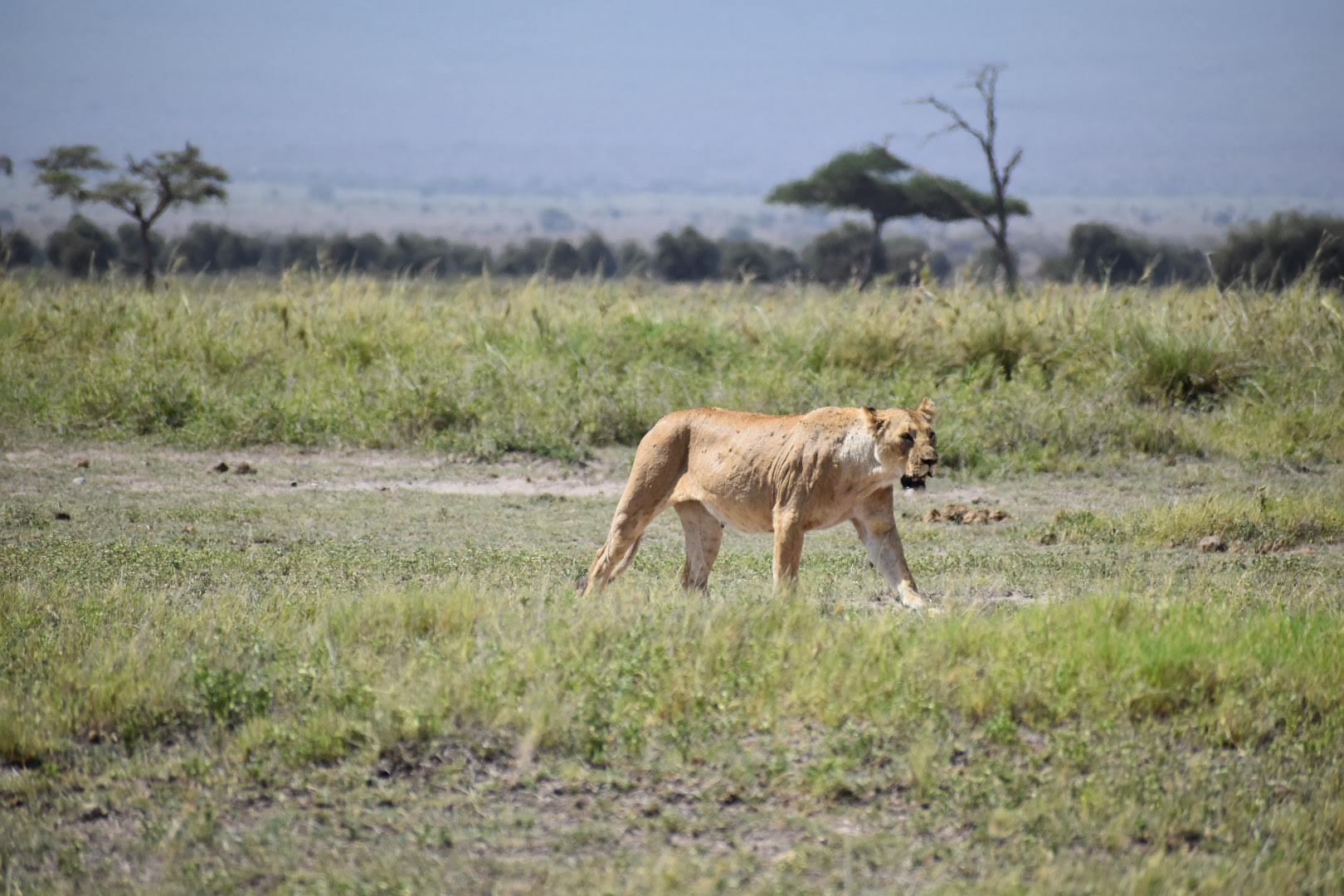


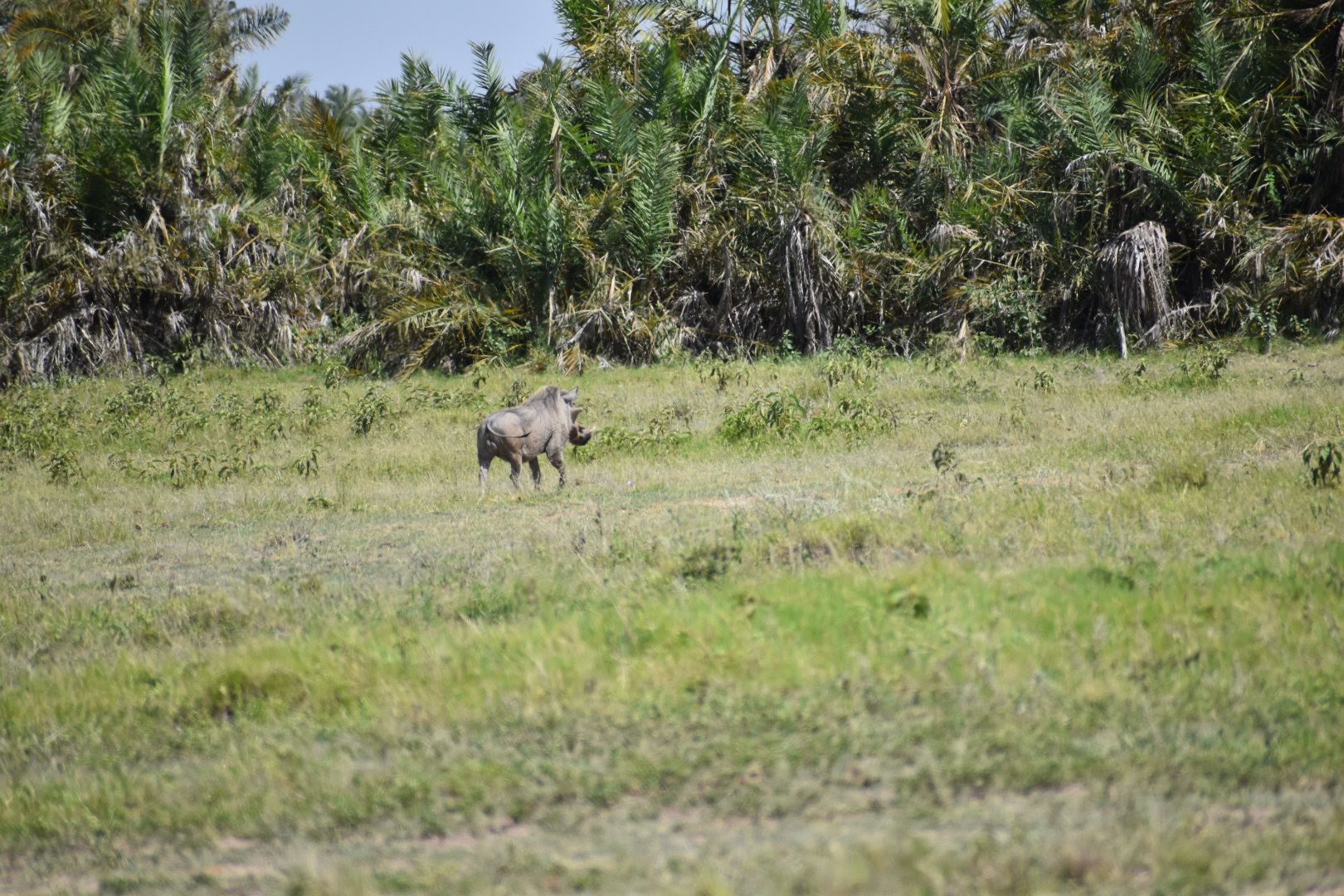
We set off again headed this time to a different part of the park. As we drove there, it was quite warm, and you could see the dust raised behind us on the dirt road. We saw some Impala, our first Thomson Gazelles and then a magnificent Kori Bustard all by itself. We then saw a troop of Baboons, another herd of Wildebeest, a herd of Elephants and a large herd of Buffalo, right at the edge of the swamp and browsing on a field of grass. It was interesting to see these animals grazing, but always keeping watch for predators. This is something quite easy to miss on a Nat Geo or Discovery show, or a YouTube video. But in each herd, you can see the animals remaining alert while feeding, in some instances partnering with a buddy who will look in a different direction.


Around 11.40am, we spotted a pair of wonderful looking birds. Daniel told us that they were Grey-crowned Cranes, the national bird of the neighboring country of Uganda.
A few more elephants, impala, gazelles and another hippo (this one lying on its side) we spotted the magnificently colored Malachite Kingfisher next to a culvert. Right after that, we saw a juvenile, and then a fully grown pair of Masai Ostriches, one male and one female.




By now it was past 1230 and we were all feeling peckish. Daniel said he had a spot planned out for lunch that would involve 15 minutes of climbing up a hill, but where we could get a good view of the entire park. Soon, we were at Observation Hill and climbed up the 300 or so feet to the top where there was a covered structure with picnic tables underneath. Daniel and Amos lugged up the lunch supplies – 2 coolers worth and set up at the table. What a view! We could see the entire park around us. Lunch was sandwiches, salad and some chicken & lamb made that morning in Porini Amboseli camp, all washed down by cokes and sprites (in bottles). We got to know Steve, Cindy, Daniel and Amos a little better over lunch; turned out that Steve had climbed Mt. Kilimanjaro 15 years earlier on another safari to Tanzania. Both he and Cindy were avid hikers and enjoyed the outdoors. After lunch, Steve helped me tag a name to the bird I had seen all morning – a Superb Starling.
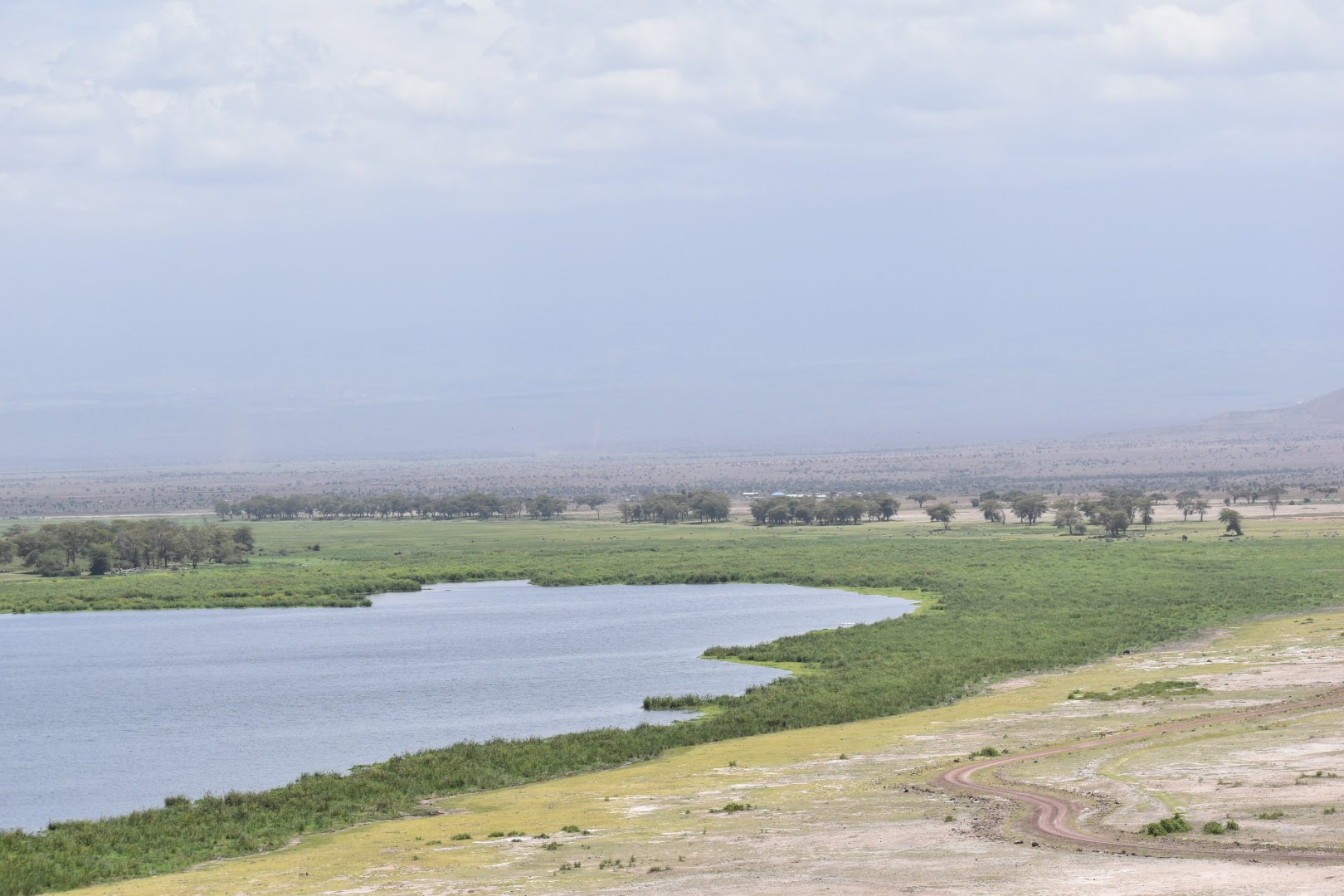

We set off down the hill around 1345 and hopped into our Landcruiser to continue our game drive. Soon, we were again amongst elephants and zebras, before spotting our first African Fish Eagle. I later learned that this is sometimes called the “Sound of Africa”; listen to it here (credit Rory Nefdt).
Right after that we spotted a pod of Great White Pelicans along with some Plovers. The Pelicans seemed to be doing a ballet as they swam along, dipping their heads underwater in unison to feed. This synchronized swimming was a mesmerizing sight and went on for the entire 10-15 minutes that we watched them.


About 1430, we decided to head to camp and settle in before the Evening Game Drive. This turned out to be a dusty 90-minute drive over some bumpy dirt tracks. We passed through a couple of Masai villages waving at many Masai children, and a small town before arriving at Porini Amboseli camp around 4pm local time.

At the camp we were greeted by Jackson, the factum factotum and the resident assistant manager! Jackson is a tall, Maasai man who grew up not too far from Amboseli. A very interesting person – more about him later. He briefed us on camp procedures – especially the stricture against walking around unescorted after nightfall (we were asked to whistle for someone to come get us from the tent when we were ready for, say, dinner!). We also learnt that Wi Fi was non-existent, and we had data service only near the lounge tent. After lights-out, charging devices and such had to be done at the manager’s office tent. We were also asked to give a heads-up when interested in a camp shower – more on that later. Soon we were at our tent settling down for a rest after a long day.



At about 1815, it was time for our evening Game Drive and sundowner. Daniel and Amos, Steve and Cindy, and Iris and I hopped into the Land Cruiser and off we went. We spotted Grant’s Gazelle and learned how to distinguish them from Thomson’s Gazelle (Grant Gazelles have a white portion above their tails), saw yellow-necked Spurfowl, a Gerenuk (a beautiful, long-necked antelope that stands up on its hind legs to pick at leaves from bushes and short trees), a Goshawk (we couldn’t identify the sub-species), Helmeted Guinea Fowl, and, as we were treated to a magnificent sunset over this corner of East Africa, a beautiful Eurasian Roller.



We stopped off for our sundowner at a waterhole very close to the camp. A deck had been erected right behind the waterhole to provide a view of animals and birds as they came to tank up their bellies. It made for a very pleasant spot for a Gin and Tonic, but unfortunately, we didn’t see much that evening. But there was no disappointment – we had had quite the day already! After our sundowner, we headed back to camp and spotted the Southern Cross for the first time! I’d quite forgotten that we were south of the equator in Amboseli, but Cindy had Daniel show it to her. Once we got back, since it was dark, we were escorted back to our tent. At 8pm, we headed back to the lounge-mess tent for dinner. A cheerful campfire was going in the fire pit right outside the tent. (Later I heard, but haven’t been able to verify, that the Maasai prefer to make small fires and take pride in doing so.) We sat down with Steve and Cindy and had a wonderful dinner with plenty of good conversation. Sadly, we learned that they were headed out to another camp the next morning from the local airstrip in the Conservancy. Cindy was quite emotional at leaving Amboseli looking back at her wonderful Safari and, having finally seen the Southern Cross, her heart was o’erflowing. I was very touched by her display of emotion. Looking back at it after 3 weeks, I find it truly amazing that Iris and I should make such fast friends in the space of a few short hours with two people that we may never meet again. That’s at least in part due to the magical atmosphere around the campfire – camping, however luxurious, takes us back to simpler times! Despite our rugged skins, constructed over years to show little in terms of emotion (to avoid hurt?), under the covers we are social animals that need the human connection to learn, thrive and live! Perhaps, that’s why children are so endearing – they have had no time to develop that skin?! I sincerely hope we run into Steve and Cindy again down our life’s journey, they are wonderful people, fun to be around and I felt we learned from them over the single day we spent with them.

After dinner and after a few more minutes around the campfire, where Jackson told us about how he went to school (he walked 10 miles each way daily, and frequently alone!) we retired to our tent for the evening. It had been a long day with a lot to digest! It took a while for me to get to sleep with the sounds and smells of the African night in the background.
The next day we were woken at 5:45am by a Maasai gentleman, Titus, who came to give us a jug of warm water for washing, tea for Iris and coffee for me, done perfectly in a French Press. Overnight, Iris had heard the monkeys around the camp chittering (I slept right through it!) and she asked Titus about it. He said it may have been a leopard that caused the monkeys to be alarmed; that sent a delicious shiver down our spines! The sun wasn’t due to rise till about 0630, so we quickly got dressed, gulped down our tea/coffee and were escorted to the lounge tent. There we saw Steve and Cindy at breakfast, getting ready to head out to the airstrip separately. We quickly exchanged email addresses, said goodbye and headed to the back of the camp where the Land Cruiser was parked with Daniel and Amos waiting for us. So began our morning Game Drive in Selenkay Conservancy.
You are probably wondering what on earth a Conservancy is versus a National Park or a Reserve. This may be a good time for a short primer.
| National Parks are public land managed by the Kenyan Wildlife Service (KWS). National Reserves are community land managed by the County Government that can partner with KWS for its management. Conservancies are typically privately owned, sometimes by a community or a corporation, and set aside for specific purposes such as improving the socio-economic status of the community, and to conserve wildlife. In Kenya, about 8% of the land is in National Parks and Reserves, while Conservancies cover another 10%. Conservancies can be as rich in wildlife as National Parks and Reserves. Since they are privately owned, it is possible to go off-road in a Conservancy, or on a night game drive, while those are prohibited in a National Park or Reserve. Later in our Safari, while at Porini Cheetah camp, I learned that the Ol Kinyei Conservancy was owned by the Maasai people. In fact the staff at the camp were the landowners, while the camp’s owner effectively leased the land from the staff and other Maasai people outside of the camp! The camp’s income was at least partly distributed back to the landowners i.e., the Maasai, some of whom also worked for a wage as staff members and guides. |
Back to our morning game drive! As we set out, we saw our (by now) usual crew of Gazelle and Impala. Shortly thereafter, we spotted a common Drongo (with a most uncommon tail!), and then a Long-tailed Fiscal (a type of Shrike). The ubiquitous game fowl were out in force, pecking away for insects and worms on the cold, dew-covered ground. We then saw a red billed hornbill, followed by a family of Pumba (Warthog) digging for roots and later an ungainly baby Wildebeest with its parents, who were busily chomping away at the grass. There was also an eagle (probably a juvenile Martial Eagle) occupying a tall tree.




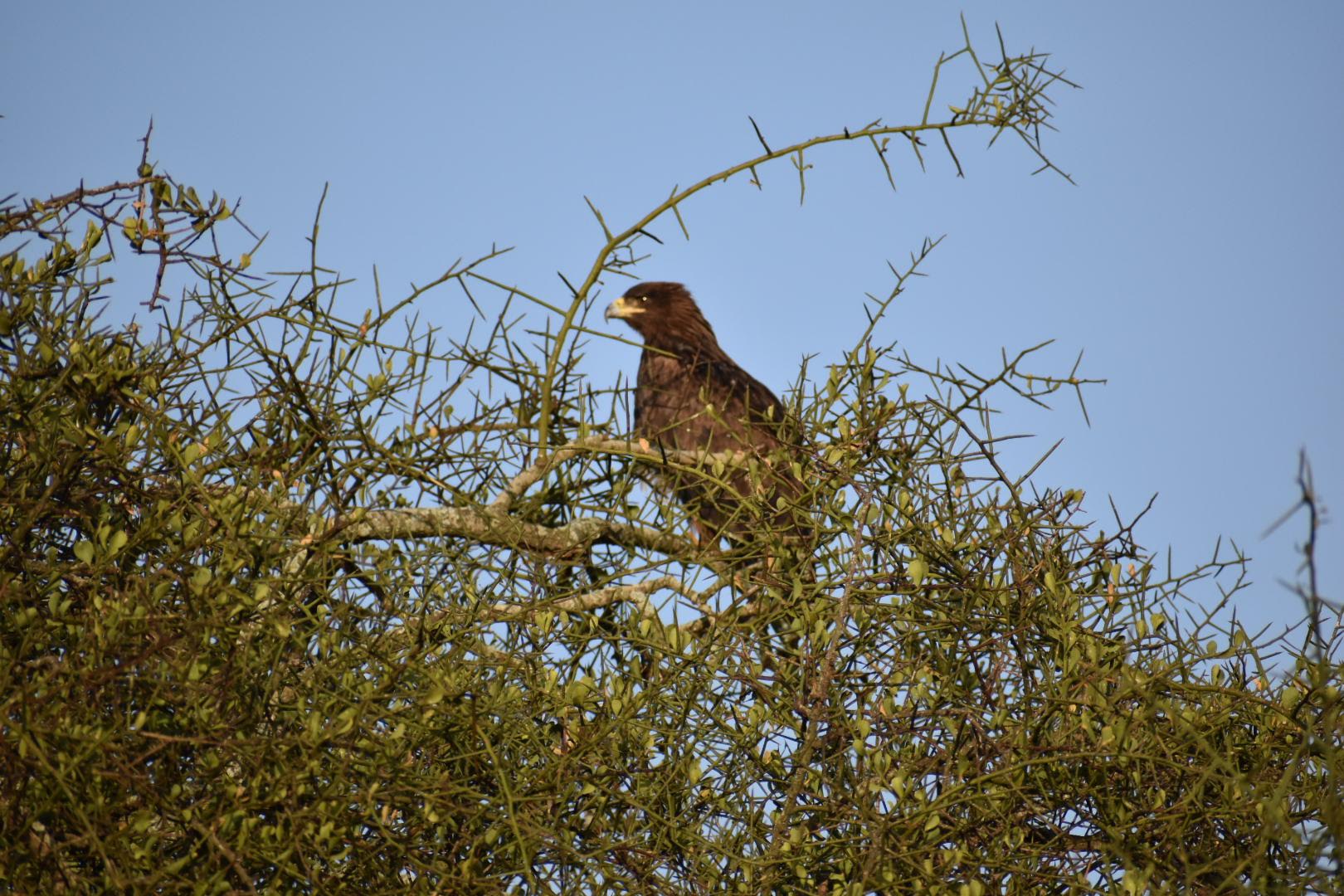
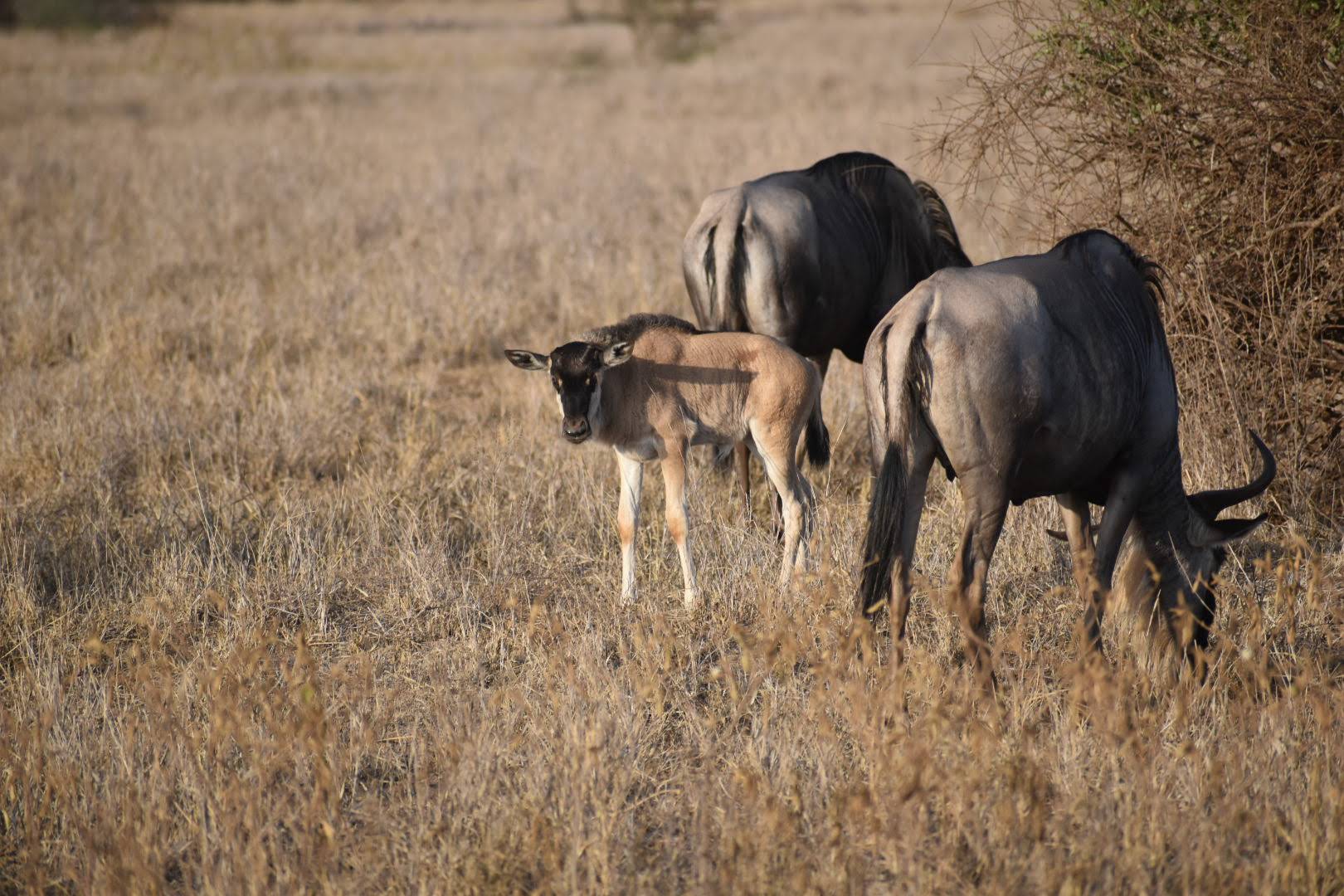
We saw plenty of weaver bird nests (there are dozens of sub-species of Weavers) on the Acacia trees around the Conservancy. Daniel, our Maasai guide along with Amos, told us how to tell the cardinal directions by simply looking at which side of a tree the weaver nests predominate! Apparently, they always build their nests towards the west of a tree to better handle the prevailing wind direction! Following this, we saw a common Buzzard, a majestic Tawny Eagle, a black-bellied Bustard and a pair of Jackals. Did you know that Jackals are monogamous and mate for life?!
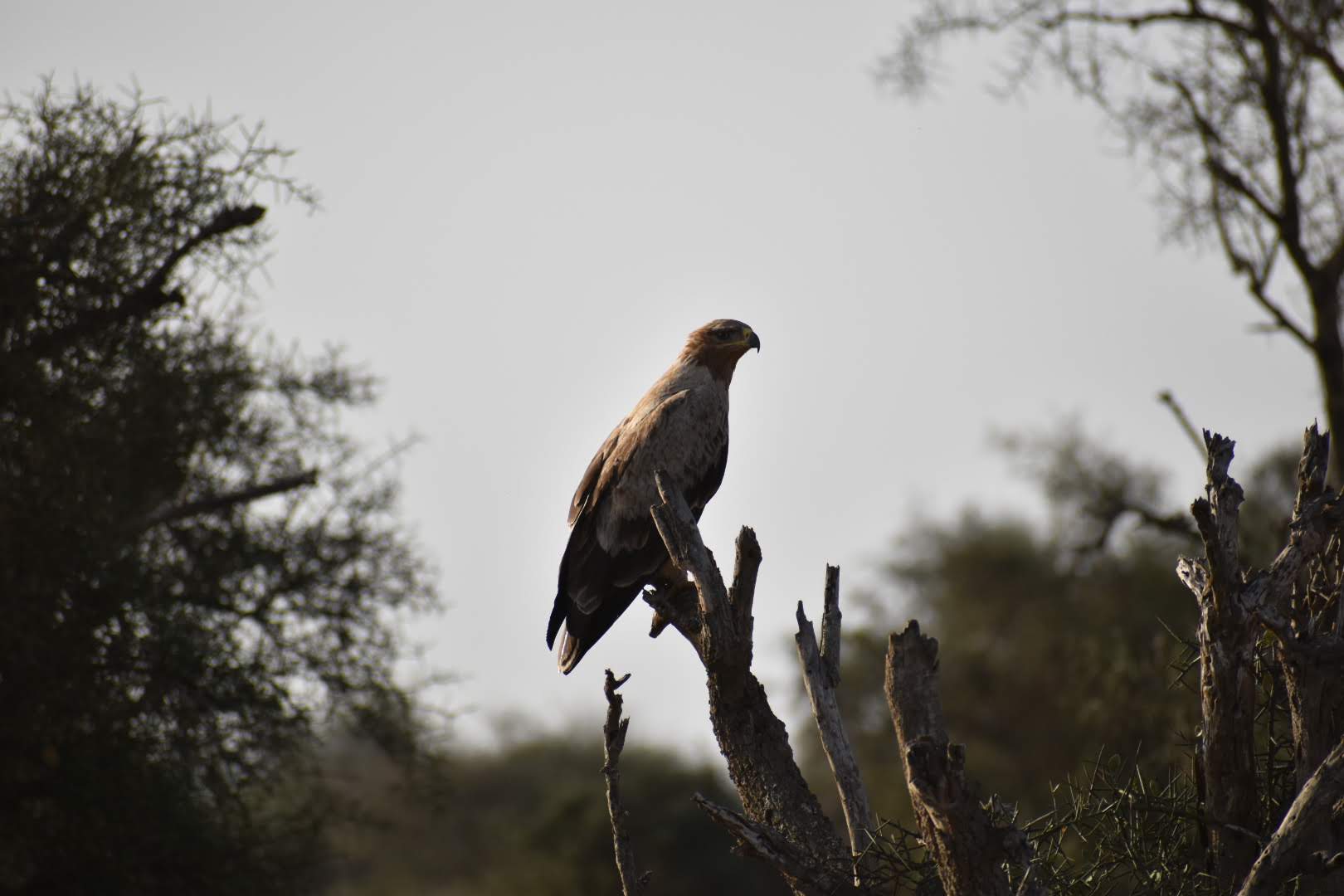


As we turned a corner, we almost ran into a herd of Zebra and, right behind them a small herd of Giraffe! Throughout the Safari, we found that younger giraffe are invariably curious and stare at you, curious and unafraid, while older giraffe tend to be skittish and hide behind the nearest bush or tree once they spotted you.


A few minutes later, we saw a beautiful Lilac-breasted roller and then spotted the White-bellied Go-Away bird, named for its call that sounds like “Go Away”; listen to it here (credit isaac kilusu).
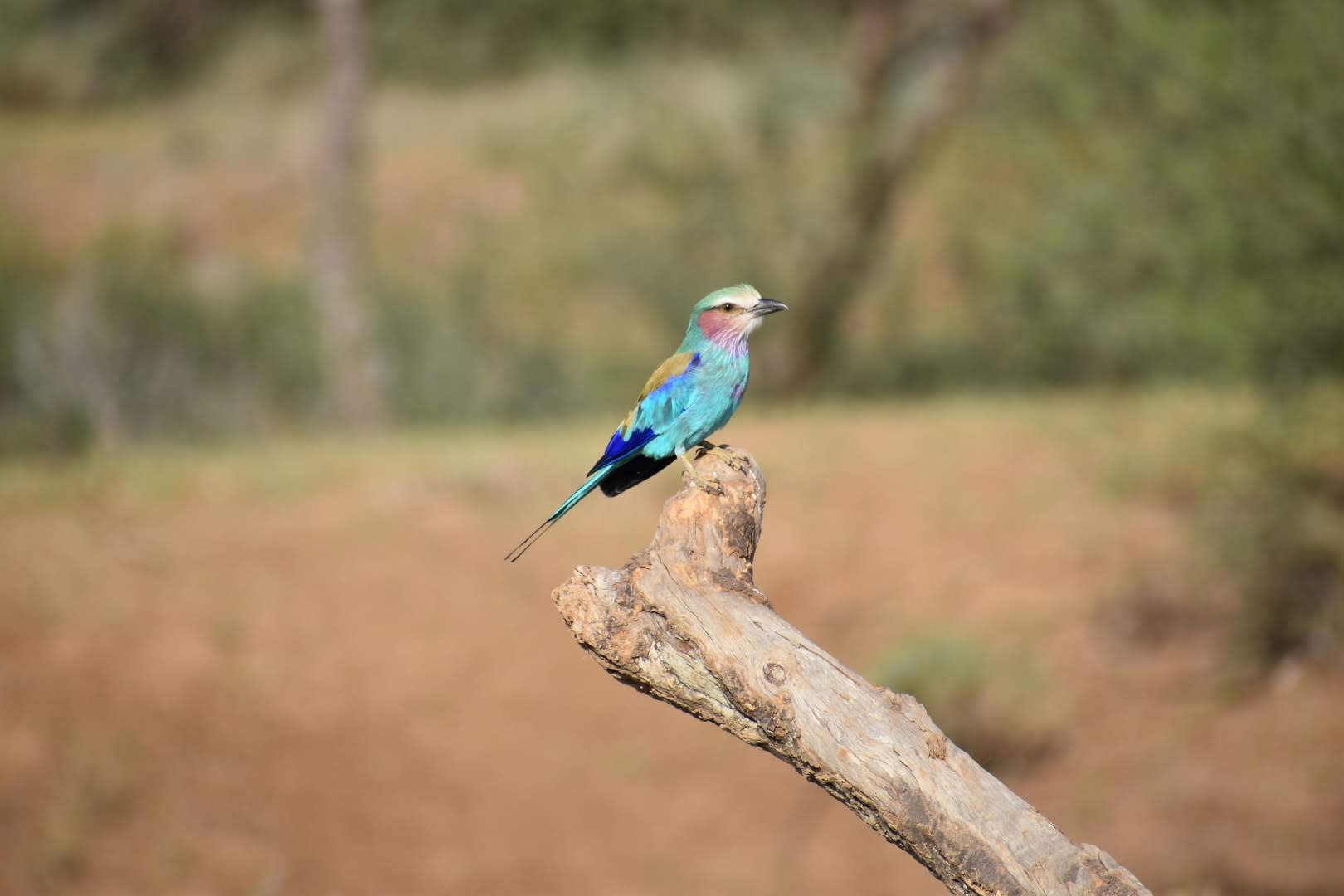

With that, we headed back to camp around 0900 for breakfast, again a very satisfying affair! Steve and Cindy had departed, and we were the only guests in camp, but we expected 2 more guests to join us around lunch time. After breakfast, Jackson had arranged for four of our camp’s Maasai staff to take us on a walk outside camp!
Off we went with James, Peter, Jonathan and Ornato, our fearless protectors! Jonathan and I walked together, and I learned quite a bit. Each was dressed in traditional Masai garb – red and black checked tops, a shawl made of the same material, and a bottom kilt. Each had a machete by their side. None carried spears, but Ornato had a walking stick.
On the way, we learned about the toothbrush plant – the Maasai break off a twig from this plant, sharpen one end for a toothpick and chew on the other, blunt end for dental hygiene. It works! Maasai have wonderfully white teeth, though not always straight. Jonathan then identified different kinds of animal poop – giraffe, elephant, impalas and gazelle – and showed us how to differentiate between them. They showed us tracks and how to identify some animals from these tracks. I then learned that it is not uncommon for Maasai men to set out at daybreak with their cattle and sheep, walk 50 miles with a snack of some milk and cow blood, and then head back to their village for their evening meal!
The Maasai are amazing people, incredibly knowledgeable about their environment, simple-yet-sophisticated, hardy, brave, smile easily, and have learned to live harmoniously with the land.

Post the walk that lasted about an hour, we headed back to camp for some R&R. A little later after noon, we met Kaitlyn and her mom Kyle from Atlanta, GA. They had just arrived on a flight from Nairobi after getting there almost a day late (having missed a connection in Europe). While we waited for lunch, we found that some Maasai people from the local villages had delivered their wares to a small hut in camp. We went shopping and picked up a few bracelets and such! The mark-up on these was exorbitant, but we were assured by Jackson that the proceeds went straight to the widowed women who made these trinkets. After lunch, we retired to the tent. I sat outside watching the monkeys while Iris chilled inside. One monkey came right up to a tree facing the tent, 2 steps away and I was able to take a good photo.

Around 3:30pm we headed back to the lounge tent for a cup of tea before our Evening Game Drive. There we met Kaitlyn and Kyle again, and Julius their guide. Kaitlyn used my phone to text her Dad back in the Atlanta, GA area (her phone wasn’t connecting to the SAF Kenyan mobile network; mine somehow worked).
After a quick cuppa’ we headed off to our separate Land Cruisers around 4pm.
On this game drive, we saw some more shy Gerenuks, another family of Pumbas, and another herd of Giraffe. The Giraffe were right beside a waterhole, and it was fun to see them spread their forelegs and bend their long necks to take a drink. They are very vulnerable when drinking water and take turns to keep a watchful eye out for predators.
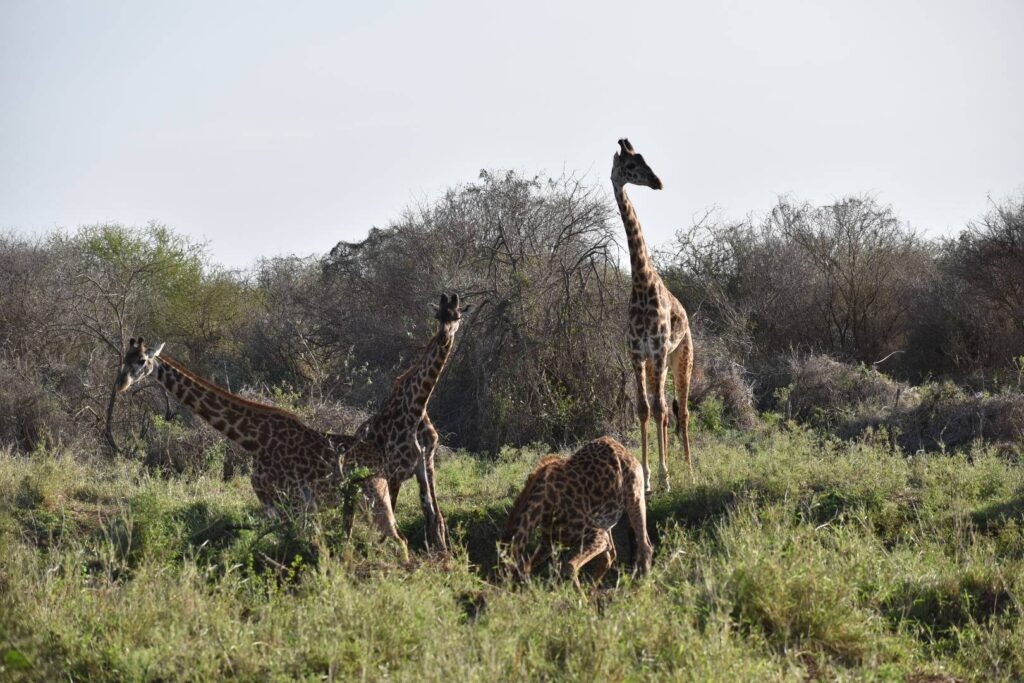
After a few minutes watching them, we headed off to see more Zebra, Wildebeest, and Impala. Eventually, a few minutes before sunset, we found ourselves on this raised plateau and spotted our new camp-mates Kaitlyn and Kyle with Julius and his partner. There we alighted and were treated to another gorgeous sunset – Kaitlyn and I had Gin and Tonics while Iris and Kyle sipped at a glass of white wine. (Unfortunately, I never did catch Julius’ partner’s name).
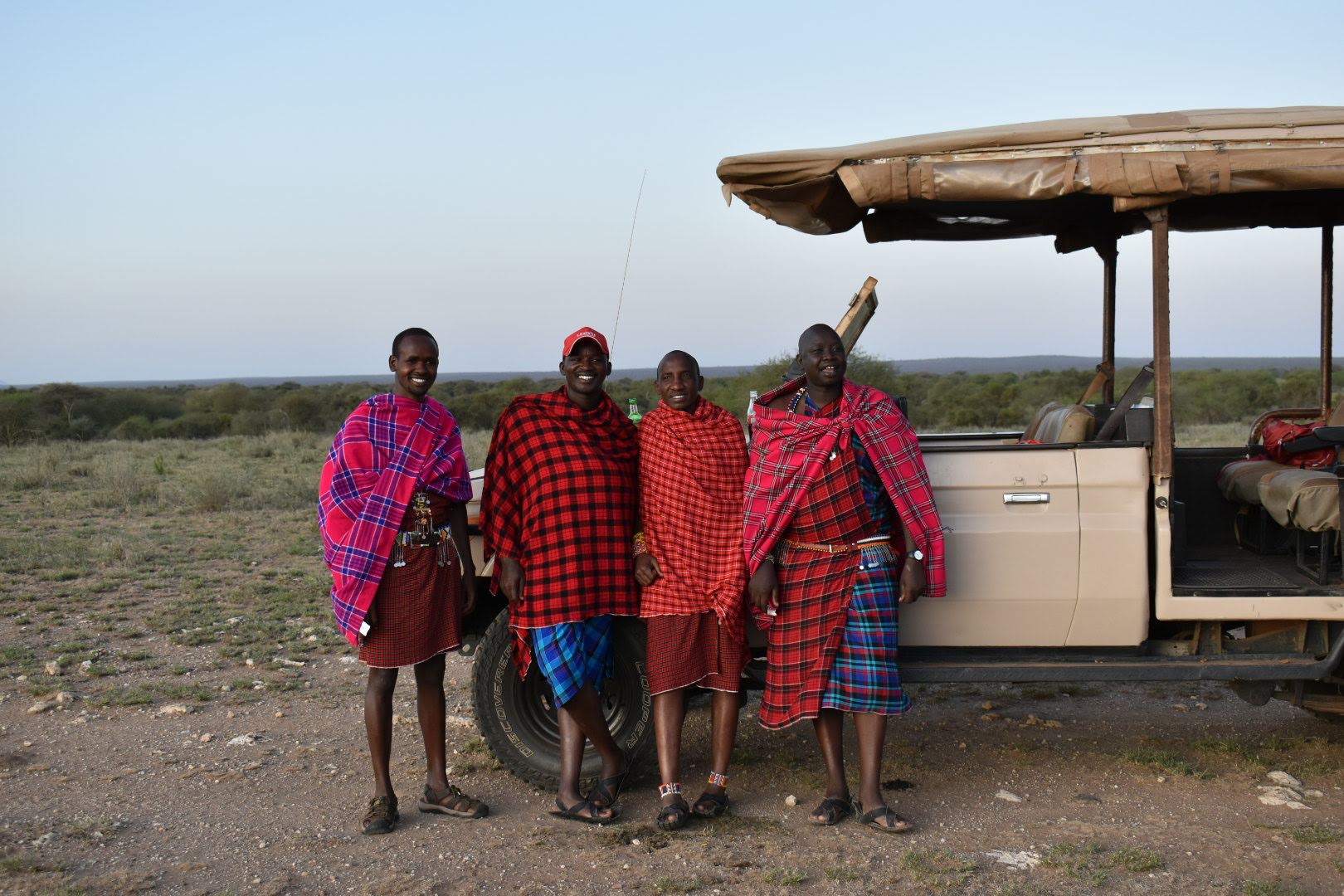

With that, we headed back to camp for a well-deserved shower. On the way back, Amos tried to use his red spotlight to see if we could spot any nocturnal animals. We did see a hare of some kind, but not much else.
Back at camp, Titus came by with 2 buckets of warm water (per person), filled up the camp shower bucket and pulled that up the tree using the rope-and-pulley arrangement. We each had blissfully warm showers and worked out some aches stemming from the frenetic pace of the last couple of days. We then headed off to dinner, escorted to the lounge tent of course, but first stopped at the campfire for another gin and tonic. There, the manager came by and said Hello and asked about our safari so far.
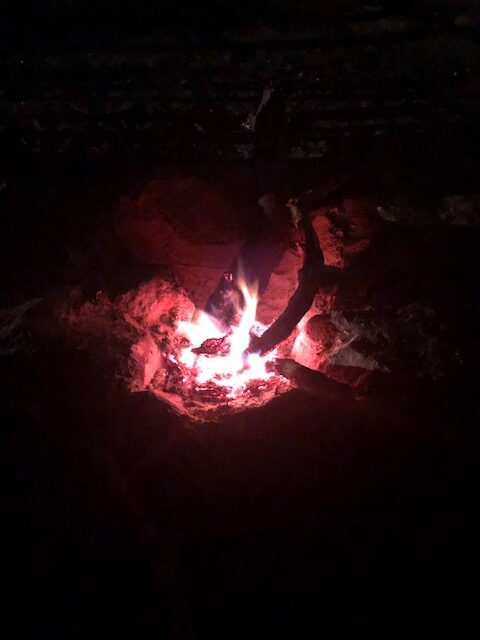
This evening at dinner, we met again with Viraj (we had met him at the sundowner the previous night). We had some stimulating conversation on conservation and his efforts as part of a project named “Earth Acre” to identify and quantify the (positive) impact on carbon from Conservancies and find ways to monetize that. The project is in its early stages and what little about it that is online is here.
Later, as we were enjoying dessert, Jackson and the entire camp crew walked into the lounge/mess tent and entertained us with the traditional Maasai dance! This involves singing while in a semi-circle. Each man takes turns coming to the center of the circle and jumping as high as he can (a standing jump of 3 feet is quite common amongst the Maasai!).
After dinner, we headed back to our tent to pack up and be ready to leave at 0615 the next morning – we had to be back at the Amboseli National Park airstrip by 0800 to catch our flight back to Nairobi and connect there for a flight to Samburu in the north of the country. Kaitlyn and Kyle were going to stay at Amboseli a couple of days before heading to Porini Rhino camp (not on our itinerary) and we expected to meet them again towards the end of our Safari at the Ol Kinyei Conservancy near the Masai Mara.
We had another interesting night filled with animal sounds (mostly monkeys), and woke up the following morning at 0530 to coffee, tea and the jug of warm water that Titus brought us again. We scrambled and made it to the lounge/mess tent by 0615 to grab a quick breakfast. It was 0635 by the time we (Kaitlyn and Kyle were headed to Amboseli National Park with us) left, and I was quite concerned about making it to the airstrip on time. We said goodbye to Jackson, Daniel and Amos. Julius (he was driving this time) drove at breakneck speed and soon we were past the two Masai villages and on a combination dirt-gravel road where he could drive at 40 mph. Suddenly, he stopped, and we unexpectedly saw that most glorious of sights: A cheetah to the right of and just off the track, that we had disturbed! I have no idea how Julius saw him but then, Maasai have amazing vision. My camera was packed away, but I managed to capture a quick photo on my phone before the cheetah silently vanished into the brush.
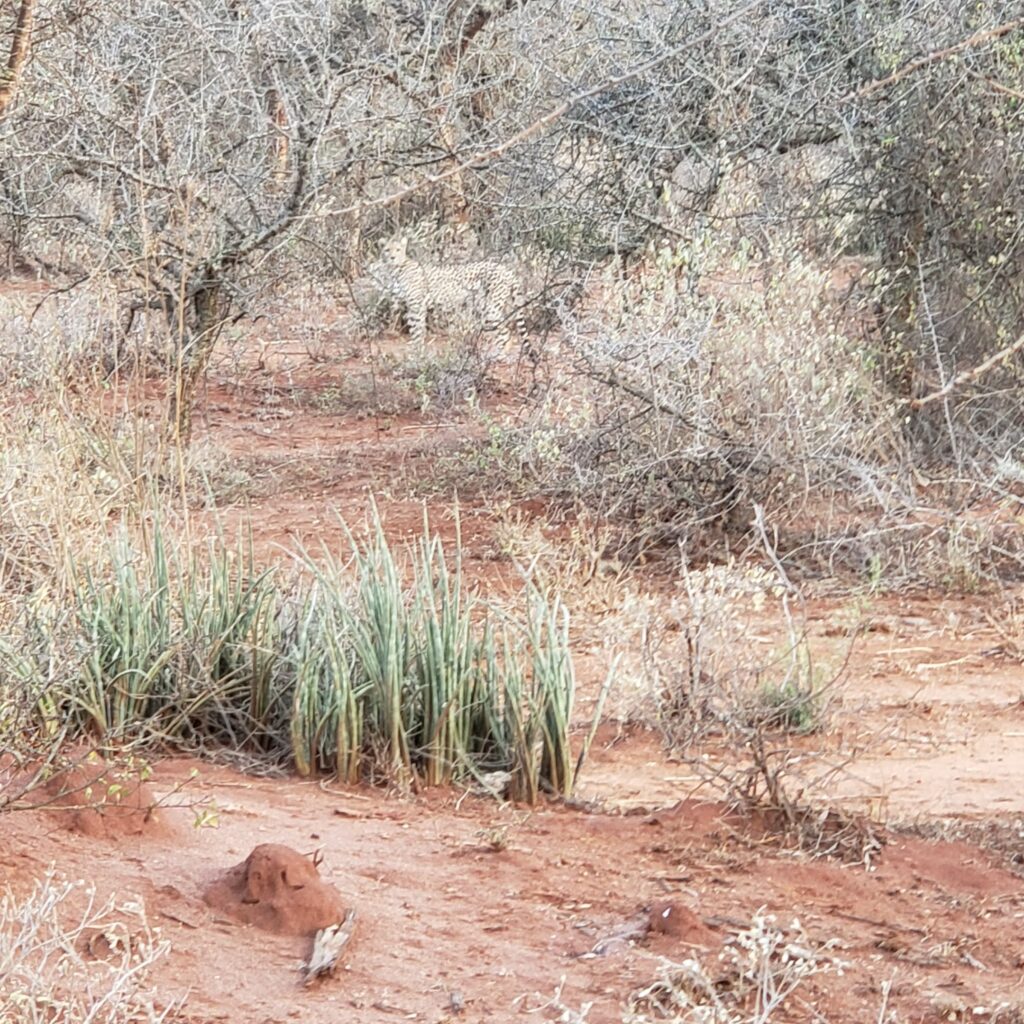
That’s Africa for you, full of surprises. You must keep your eyes open at all times, for you never know what you will see, and when!
We made it to the airstrip just before 0800 and even had time to get pictures of a few more birds in the marshland – a Saddle-billed stork being the highlight.

We waited 10 minutes for our flight to land, took one final photo of Mt. Kilimanjaro and then boarded (We had no boarding pass mind you! The captain had an iPad with everyone’s details and checked us off.).


We took off a little after 0815 for the 45-minute hop back to Nairobi where we were to board another flight to Samburu. With that, the first leg of our Safari was over, but our adventure was just beginning!
Random Tidbits and Musings:
- Amboseli National Park is a gem of a place! Elephants and Buffalos abound, and we were lucky enough to spot a lion pride on the very first day of our Safari! We had plenty to see on our day in Selenkay Conservancy, but we didn’t see much of the cat population until we saw the Cheetah on our way to the airstrip. I suspect we didn’t spend enough time here, that’s probably why. But then, these trips involve making decisions with incomplete information – so not kicking myself for that.
- Porini Amboseli camp is lovely! It is rustic, yet comfortable. The staff made us feel so at home – whether it was Jackson ensuring we understood the day’s program, Titus taking the time to explain how the camp shower worked, or what water to use for brushing our teeth (!), Jonathan and Ornata explaining the subtle differences between Giraffe poop and Impala poop, or Daniel and Amos explaining some nuance of animal behavior while ensuring we didn’t miss anything that mother nature decided to show us.
- The food was wonderful, and we ate way too well! Every dinner started with a wonderful soup – always vegetarian, always pureed and always perfectly flavored. Then a well-balanced main course, and a dessert. Bread was these tiny, pillowy-soft baked rolls. Breakfast always had 4 different kinds of fruit, eggs and meat for those who wanted them, pancakes/toast, baked beans and coffee/tea. Lunch was quite like dinner.
- Bugs! The second afternoon at Selenkay Conservancy is when we first ran into Tsetse flies. These are man-eaters! Thankfully, the Landcruiser had bug spray handy, and these denizens of the bush left us alone after a generous application. Hardly saw any mosquitos anywhere, but we were on this pill called Malarone for safety’s sake.
- The Toyota Landcruiser is a monster of a machine! It is seemingly indestructible, can go up a 45-degree rocky or muddy and slippery incline (we did that a couple of times on the way to camp) and handle rough tracks with aplomb. At Amboseli We got stuck once and just had to back up and try again to get unstuck. Toyota deserves a big shout-out for engineering this vehicle.
- Porini/Gamewatchers has a policy of including a spotter on each vehicle in addition to the driver. Both driver and spotter are guides and doing this ensures that nothing is missed because the driver is trying to negotiate difficult terrain or is distracted by a question. I really applaud this policy – it’s a win-win for the company, the clients and the local community. Guides go through a 1-year school/training program – we heard about the Koiyaki Guiding School in the Mara later in our Safari – that includes a foreign language in addition to English. Guides graduate with a certificate.
- While Covid didn’t spare Africa, masks were not needed throughout the trip except in population centers. All staff at camp were vaccinated (Astra Zeneca) but had not yet had booster shots. Most of our time with people was outdoors except for meals at camp which were in an open or semi-open tent.
- Gear: While it is possible to dress in street clothes, investing in technical clothing intended for Safaris is the way to go! I bought a few shirts from Columbia and REI, and a few pants from Columbia and Coalatree. A good pair of waterproof boots helps too – though you will not be doing much hiking, when you do take a short walk, it is useful to not have to worry about mud. Rain gear is a good idea too. I picked up a Nikon D5600 DSLR with extra batteries and memory cards for this trip, along with a 70-300mm lens. I am still congratulating myself for this – I don’t get along too well with binoculars and this lens is light enough and quick enough to do double duty as a camera lens and a way to bring distant birds, animals and fauna into focus for viewing. Great purchase! I looked into mirrorless cameras but shied away from these due to the headache of excessive battery consumption.
- Before I forget. Plastic bags are banned in Kenya resulting in a much cleaner country than most. Don’t even bring plastic, duty-free bags into the country.
I urge everyone reading this to consider a Safari to Kenya. If you do decide to go, let me know and I can share more detail on what to expect.
(Photos can be found on this Google Photos Album.)
To be continued…
Pingback: Safari to Kenya – Amboseli to Samburu – Srini’s Blog
Could never have guessed jackal’s conjugal disposition :). Btw, I really like those tidbits in boxes.
Jackals are amazing creatures; later on the trip, we saw a pair that was taunting part of a lion pride – amazingly brave. Thanks : ) I should remember to do the box thingy more often.